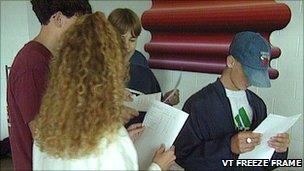Does cash get results in schools?
- Published

Do the sums add up when it comes to money spent against results achieved?
The novel inclusion of school-by-school spending figures alongside academic results in the English secondary school league tables, published on Wednesday, has been described by the government as part of its drive for "transparency".
However, at a time when the government is facing criticism for spending cuts, it is easy to see the advantage to be gained by identifying those schools that are spending more than others.
With many schools expecting to receive real terms cuts in their budgets from April, this might be seen as the rugby equivalent of "getting your retaliation in first".
The government's argument is that there are "significant savings to be made". As it says, if a typical secondary school is spending £1,000 more per pupil than its neighbour, that amounts to an extra £1 million a year.
However, as the government agrees, there can be good practical reasons why two neighbouring schools might spend very different amounts of money, even if their pupil intake, staffing levels, and class sizes are similar. Let's look at a tale of two schools.
School A and school B
School A has draughty, poorly-insulated 1970's flat-roofed buildings on a split site. It has to transport pupils to its sports fields several miles away and pays to use the local authority's swimming and leisure facilities. It has experienced teachers, who are mostly at or near the top of the incremental pay grades.
School B is newly-built, energy efficient, on a single site with all sports and other facilities within walking distance. It has a young staff, mostly near the bottom of their incremental pay grades.
These two schools will have very different energy, building maintenance, transport and staffing costs.
But it does not necessarily follow that school A is being wasteful in its spending - it just has to deal with different circumstances.
To be fair, ministers say they are not seeking to "point the finger" but rather to encourage schools and parents to "go compare". But that very phrase suggests they are comparing like with like, when often they are not.
Publishing these spending figures is not just about highlighting potential savings but also appears to have been done in order to suggest that throwing money at schools does not necessarily bring better results.
School league tables
Find secondary schools in your area
In an accompanying analysis of the figures, the government concludes: "Those spending more do not always do better".
Indeed, it asserts there is "no correlation" between spending and results.
Spending and results
So is it true that spending has little effect on results? This question has absorbed the energies of academic economists for decades.
Sadly they have failed to come up with any conclusive findings. One major study (by Hanushek and Kimko, 2000) looked at pupils' international maths scores and compared them to several different measures of school spending.

It is not clear whether spending more on schools leads to better results
Their conclusion was: "The overall story is that variations in school resources do not have strong effects on test performance."
Another study, by Francois Leclerque for UNESCO in 2005, surveyed a wide range of other economists' attempts to find a correlation between resources and results.
Some found a positive correlation. Others found the opposite.
Leclerque concluded that, whichever view you took, it was as much a matter of one's previous belief and opinion as it was of scientific knowledge.
So are there any answers to be found in the recent big international surveys of educational achievement?
The recent Pisa study from the OECD, which compared academic performance across a wide range of countries, appears to offer some support for the government's view that money is not a key factor.
It concluded that a country's wealth explained only 6% of the difference in average student achievement. The other 94% was down to other factors.
The Pisa report argued that the image of a world divided into rich and well-educated nations and poor and badly-educated countries was "out of date".
Teachers' pay
The only strong correlation noted by Pisa was between good results and higher teachers' salaries relative to national income.
In other words, countries that invest a higher proportion of their wealth into teachers' pay do tend to get better results.
By contrast, spending money on smaller classes does not seem to correlate with better results.
However, digging a little deeper, Pisa found that the most financially advantaged schools tended also to be those with more middle-class pupils - although it is worth noting that in England funding formulas divert extra cash towards schools with poorer pupils.
And while there was only a small variation in student performance that could be attributed solely to the level of resources, there was an 18% variation in results when both resources and the socio-economic background of students were taken into account.
This perhaps explains why, in another OECD report ("Education at a Glance, 2010"), the countries and regions that top the international league table of reading standards are those that are both high-spending and have more affluent populations.
Seven of the top 10 are characterised as being "high" spenders on education for six to 15-year-olds. They are Iceland, Finland, Japan, Canada, Norway, Korea and Australia.
However, three low spending regions also make the top 10 - Hong Kong-China, Estonia and Shanghai-China.
Although China shows it is possible to buck the trend, the dominant pattern appears to be that a combination of higher spending and higher levels of socio-economic background correlates with achievement.
'No conclusive evidence'
Overall, though, there is no conclusive evidence of a clear relationship between spending and results.
While this is politically useful at a time of national austerity, it also raises questions about why the government is introducing the pupil premium - extra funding to schools for each pupil eligible for free school meals.
After all, why spend more on schools with poorer pupils, if there is no correlation between cash and results?
When I put that to someone close to Education Secretary Michael Gove, they paused a while and said "that's a good question" before stressing that the pupil premium will come with new accountability measures for schools that will show how the poorest pupils are benefiting from the extra money.
However, the government could also cite the international evidence that suggests that social and home background is the biggest determinant of educational success.
So spending what extra there is on these pupils may well pay off, if the OECD is right that the combination of both resources spent and social background does make a difference.
Mike Baker, external is a freelance education journalist and broadcaster